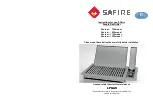
Page
15
The main cooking surfaces: The grill and optional hotplate are cast iron with a fused on matt
vitreous enamel finish. No “curing” is required, but you should give these and the warming rack
a thorough wash with regular dishwashing detergent and rinse well with fresh water before first
use. For ongoing protection of the cooking surfaces, follow the procedures in the Cleaning,
Storage and Maintenance sections.
Grease Management:
This barbeque is equipped with a two stage grease drainage system. Food residue drops down
to the grease channelling tray, then falls through the hole into the grease cup. It is a good idea
to line the main grease channelling tray with aluminium foil to assist with cleaning.
Ensure there is a hole in the foil to allow fats and oils to drip through into the grease cup below.
Also, placing fat absorbent material into the grease cup will avoid splashing and overflowing
when the container starts to fill. Suitable fat absorbent material is available from your local
Barbeques Galore store.
The grease channelling tray and grease cup should be emptied, cleaned and refitted regularly.
If not emptied, eventually a fat fire is likely to occur. Fat fires are dangerous and not covered
under warranty. If a fat fire occurs, do not try and extinguish it with water. Shut the gas supply
off and close the hood if safe to do so. Call the Fire Brigade if necessary.
Lightly coat the cooking surfaces with oil. This will reduce issues with food sticking. Light the
burners, close the hood and leave on HIGH for about 5 minutes to warm the barbeque up.
Once the barbeque is warmed up, you should set the burners to your desired cooking
temperature. You’re now ready to start cooking up a feast.
Flare-ups are caused by juices and oils from the food igniting in sudden bursts of flame that
come up over the grill. A little bit of flare up as well as the resulting smoke is a good thing. It’s
what gives barbequed food that unique outdoor flavour. But if it happens too often, or if the
flame lasts more than a couple of seconds, your food will char, so you need to control it.
Some tips that help minimise flare ups:
Trim excess fat off your meat.
The burner controls may be up too high, turning them down BEFORE flare ups occur will
usually prevent it happening in the first place.
Moving the meat away from the flare up will also reduce the problem. Note that when all
burners are on, the area of grill closest to the hotplate will be the hottest part of the grill.
Some very fatty foods can only be cooked on a hotplate or indirectly with the hood closed
(see later information on indirect cooking).
NEVER use more than half the cooking surface as hotplate. That can be very dangerous.
Clean your barbeque after each use. DO NOT use abrasive or flammable cleaners, as it will
damage some parts of the product and may start a fire. Clean with warm soapy water.
First time use
Preparing to cook
Controlling flare up













































